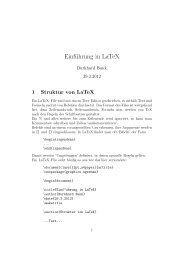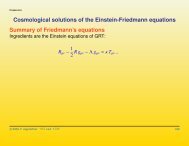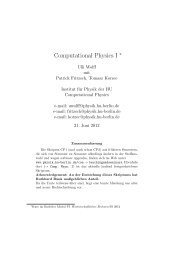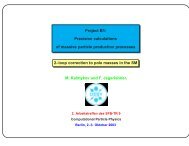Preprint[pdf] - HU Berlin
Preprint[pdf] - HU Berlin
Preprint[pdf] - HU Berlin
You also want an ePaper? Increase the reach of your titles
YUMPU automatically turns print PDFs into web optimized ePapers that Google loves.
these calculations were strong motivations for inventing and developing computer algebra codes as advanced<br />
tools to solve difficult problems by means of computers. Also the dramatic increase of computer performance<br />
and the use of more efficient computing algorithms have been crucial for the progress achieved.<br />
Already in 1959 a new formula for measuring aµ was found by Bargmann, Michel and Telegdi [70]. At<br />
a particular energy, the magic energy, which turned out to be at about 3.1 GeV, a number of systematic<br />
difficulties of the existing experiment could be eliminated (see the discussion in Sect. 2.1). This elegant<br />
method was realized with the second muon storage ring at CERN (1969-1976) [71]. The precision of 7 ppm<br />
reached was an extraordinary achievement at that time. For the first time the m 2 µ/m 2 e–enhanced hadronic<br />
contribution came into play. Again no deviations were found. With the achieved precision the muon g − 2<br />
remained a benchmark for beyond the SM theory builders ever since. Only 20 years later the BNL experiment<br />
E821, again a muon storage ring experiment run at the magic energy, was able to set new standards in<br />
precision. This will be outlined in Sect. 2.1.<br />
Now, at the present level of accuracy, the complete SM is needed in order to be able to make predictions<br />
at an appropriate level of precision. As already mentioned, at present further progress is hampered to<br />
some extent by difficulties of including properly the non–perturbative strong interaction part. At a certain<br />
level of precision hadronic effects become important and we are confronted with the question of how to<br />
evaluate them reliably. At low energies QCD gets strongly interacting and a perturbative calculation is not<br />
possible. Fortunately, analyticity and unitarity allow us to express the leading hadronic vacuum polarization<br />
contributions via a dispersion relation (analyticity) in terms of experimental data [72]. The key relation<br />
here is the optical theorem (unitarity) which determines the imaginary part of the vacuum polarization<br />
amplitude through the total cross section for electron–positron annihilation into hadrons. First estimations<br />
were performed in [73,74,75] after the discovery of the ρ– and the ω–resonances, and in [76], after first e + e −<br />
cross–section measurements were performed at the e + e − colliding beam machines in Novosibirsk [77] and<br />
Orsay [78], respectively. One drawback of this method is that now the precision of the theoretical prediction<br />
of aµ is limited by the accuracy of experimental data. Much more accurate e + e − –data from experiments at<br />
the electron positron storage ring VEPP-2M at Novosibirsk allowed a big step forward in the evaluation of<br />
the leading hadronic vacuum polarization effects [79,80,81] (see also [82]). A more detailed analysis based<br />
on a complete up–to–date collection of data followed about 10 years later [83]. Further improvements were<br />
possible thanks to new hadronic cross section measurements by BES II [84] (BEPC ring) at Beijing and by<br />
CMD-2 [85] at Novosibirsk. More recently, cross section measurements via the radiative return mechanism<br />
by KLOE [86] (DAΦNE ring) at Frascati and by BaBar at SLAC became available. This will be elaborated<br />
in much more detail in Sect. 4.<br />
Another important development was the discovery of reliable methods to control strong interaction dynamics<br />
at low energies where perturbative QCD fails to work. At very low energy, the well developed chiral<br />
perturbation theory (CHPT) [87] works. At higher energies, CHPT has been extended to a resonance Lagrangian<br />
approach [88], which unifies to some extent low energy effective hadronic models. These models<br />
play a role in the evaluation of the hadronic light-by-light scattering contribution, which we will discuss in<br />
Sect. 5.<br />
Of course it was the hunting for deviations from theory and the theorists speculations about “new physics<br />
around the corner” which challenged new experiments again and again. The reader may find more details<br />
about historical aspects and the experimental developments in the interesting review: “The 47 years of muon<br />
g-2” by Farley and Semertzidis [33].<br />
1.2. Muon Properties<br />
Why the muon anomalous magnetic moment is so interesting and plays a key role in elementary particle<br />
physics at its fundamental level is due to the fact that it can be predicted by theory with very high accuracy<br />
and at the same time can be measured as precisely in an unambiguous experimental setup. That the experimental<br />
conditions can be controlled very precisely, with small systematic uncertainties, has to do with the<br />
very interesting intrinsic properties of the muon, which we briefly describe in the following.<br />
8


![Preprint[pdf] - HU Berlin](https://img.yumpu.com/3833433/8/500x640/preprintpdf-hu-berlin.jpg)




